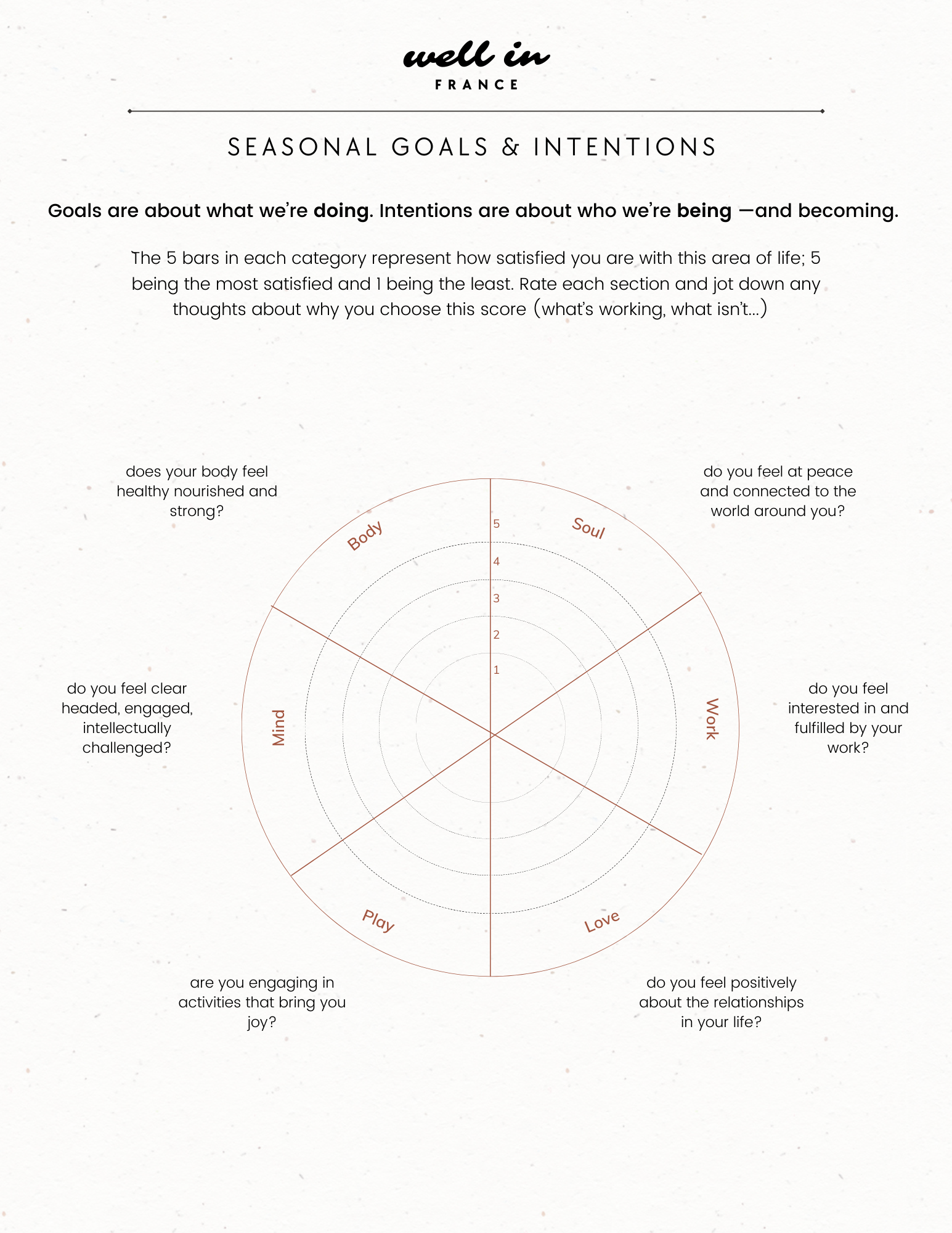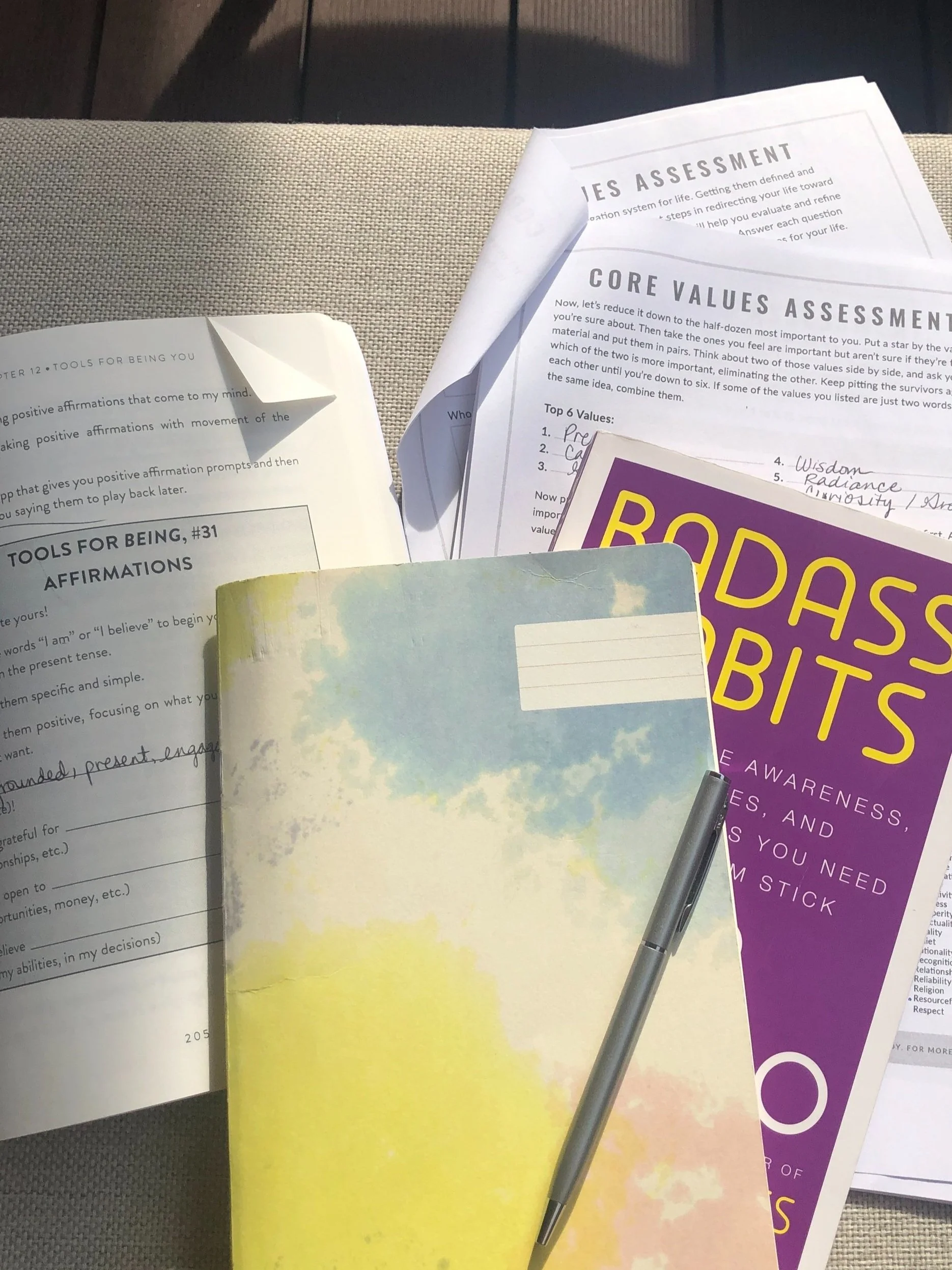Seasonal Goal-Setting: How to Identify the Most Impactful Wellness Goals
A Counterintuitive Approach to Wellness Goal-Setting
If you’re a self-improvement addict (like me), then you’re no stranger to goal-setting. Setting regular self-improvement goals is an amazing way to steer your life with intention, and focus on improving the things that matter most to you.
Most people set goals around the new year, but I’m a big advocate for seasonal goal-setting—yes, winter, spring, summer, and fall.
Think of it as a quarterly tune-up for your life, where you actually look under the hood and fix what’s broken. Without this regular check-in, it’s just too easy to fall into autopilot mode, where days blend together and months pass by without any meaningful progress.
There are tons of goal-setting templates and frameworks out there, but I’ve found a somewhat unusual approach. Instead of just setting goals based on what I want to achieve, I start with a slightly unconventional question…
THE REVERSE GRATITUDE APPROACH: “What's Bumming Me Out Right Now?”
The classic business approach to problem-solving is to start with the “pain point” and solve from there.
I do the same for personal goal-setting by asking myself a simple question: “What’s bumming me out right now?”
Often, the answers come to the surface easily. Other times, I need to sit down and go through the different aspects of my well-being, asking this question for each one.
This approach helps me identify the areas of my life that are causing friction or stress, giving me a clear direction for prioritizing my goals.
I know this might sound a bit strange—after all, we’re constantly told to focus on gratitude and positivity.
But here’s the thing: pain is a powerful messenger and motivator. Whether it’s physical or emotional, pain points us to the areas in our lives that need attention so it’s actually worth spending some time dwelling on what sucks, so it can work its magic and motivate us to take action.
The Process: From Pain Points to Action Plan
So, where to begin? To help with a thorough self-assessment, I’ve created a modified version of the Wheel of Life, which covers different aspects of holistic well-being—mind, body, spirit, work, play, and love. It’s like a comprehensive checklist for examining all the crucial areas of life that contribute to our overall wellness.
Here’s the template:
Step 1: Identify Pain Points
I go through each section of the Wheel of Life and ask myself, “What’s not working here? What’s causing me stress or frustration?”
This might take some time, so it’s important to find a quiet place where you can concentrate. You could do this in one focused sitting or keep a note on your phone to jot down thoughts as they arise throughout your day.
Yes, I actually keep a “bummer list” on my phone—a running tally of things that aren’t quite right, which I revisit when setting new seasonal goals.
Here are some examples of what might show up as a pain point:
Love: “My partner and I are ships passing in the night, and we haven’t had fun together in a while.”
Work: “I’m spending too much time on to-dos and not making progress on what actually moves the needle.”
Body: “I always throw dinner together at the last minute, so we end up eating some version of pasta every night.”
By turning nebulous anxiety into specific pain points, you now have something concrete to work with.
Step 2: Prioritize and Pick Your Battles
Once you’ve identified your pain points, it’s time to prioritize.
Look at your list and pick one or two areas that feel the most impactful to address. Maybe it’s the most painful thing, or perhaps it’s the area that feels easiest to improve.
Trust your intuition here. The key is not to overwhelm yourself by trying to tackle too many things at once.
Step 3: Create an Action Plan
Now that you’ve identified the key pain points you want to work on, it’s time to create an action plan. This is where you turn your findings into tangible steps that will help you make progress. Here’s how to do it:
Visualize the Ideal Scenario: For each pain point, ask yourself “What would the ideal scenario look like?” Get specific. This helps you establish a clear vision of what you’re working toward.
For example, if you want to cook healthier meals for your family, the ideal scenario might be: always having the fridge and pantry stocked with healthy ingredients, batch cooking two days per week, signing up for a grocery delivery service to automate the work…
Identify the Blockers: Next, think about why this ideal isn’t your current reality. What’s stopping you from achieving it? In the healthy cooking example, maybe it’s a lack of time or not having the right ingredients on hand.
Evaluate and Adjust Your Routine: Now that you’ve identified the blockers, you can pinpoint what specific actions to start and which habits to stop. For example, if your goal is to cook healthier meals, you might start meal planning on weekends, grocery shopping with a list, and setting aside time each evening to prep for the next day’s meals. Simultaneously, you could stop relying on last-minute decisions or takeout.
Calendar It: This is where the magic happens. Once you've identified the actions you need to start, the next crucial step is to put them on your calendar (likely a recurring event). This way, you’re not just hoping they’ll happen—you’re committing to making them happen. Treat these calendar entries as non-negotiable appointments with yourself!
Action Plan Examples
Let’s break down a couple of examples to illustrate how this process works:
Example 1: Cooking Healthier Meals for Your Family
Ideal Scenario: A variety of healthy, home-cooked meals that the whole family enjoys.
Blockers: Lack of time, last-minute meal decisions, and not enough healthy recipes.
Routine Changes: Dedicate Sunday afternoons to meal planning and prepping ingredients. Keep a list of quick, healthy recipes handy.
Calendar It: Schedule a recurring event on your calendar for Sunday afternoons labeled "Meal Planning & Prep." This dedicated time ensures that you consistently prepare for the week ahead.
Example 2: Stop Wasting Time on Non-Essential Work Tasks
Ideal Scenario: Focusing on high-impact tasks that grow your business, with less time spent on trivial to-dos.
Blockers: Lack of prioritization, distractions, and difficulty saying no to non-essential tasks.
Routine Changes: Implement time-blocking for deep work, set clear priorities for each day, and practice saying no more often.
Calendar It: Block out specific times on your calendar each day for high-impact tasks, labeled as "Deep Work." Treat this time as non-negotiable to avoid distractions.
It’s All About Living with Intention
It’s hard to make real progress and evolve with intention when we live on autopilot. Checking in with ourselves about what feels “off” is a great exercise to go through regularly, and doing it at the start of each new season is the perfect time.
Maybe you’ve steered clear of dwelling on what’s “not working” in your life. But remember: pain is a powerful messenger and a potential gateway to connecting with our true desires— so we can get to work on making them a reality.




